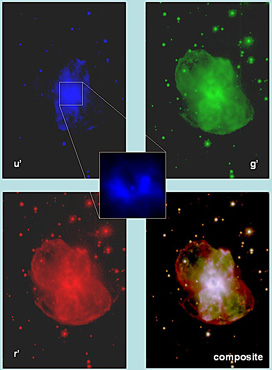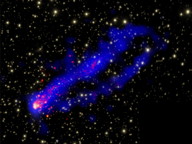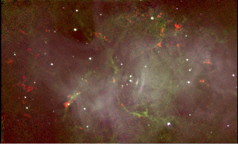Research with SOAR
MSU astronomers use SOAR to study a variety of astronomical sources, from relatively nearby sources like the Crab nebula to distant clusters of galaxies. Below are some highlights.
NGC 2440

This spectacular image of NGC 2440 was taken by SOAR in late December 2004. The planetary nebula NGC 2440 is the result of a dying star (the blue dot at the center of the enlarged box) blowing off its outer layers to form an ionized gas cloud nearly a light year across. The object lies 6500 light years away from Earth, still well inside our Galaxy. The figure shows the images that were taken in three separate colors (u', g', r'), and then the combined "composite" image.
ESO 130-001

The composite Chandra/SOAR image shows two trails of X-ray emission (blue) trailing the galaxy EXO 130-001 (optical in yellow, Hα in red). Credit: X-ray: NASA/CXC/UVa/M. Sun et al.; Hα/Optical: SOAR (UVa/NOAO/UNC/CNPq-Brazil)/M. Sun et al.
Crab Nebula

Image of the Crab Nebula taken with SOAR/Spartan showing molecular hydrogen (red), ionized filaments (Br γ, green), and synchrotron radiation (white). Loh, Baldwin, Curtis, Ferland, O'Dell, Fabian, Salomé (2011, ApJS, 194, 30) discovered 55 arcsec-sized knots of molecular hydrogen.